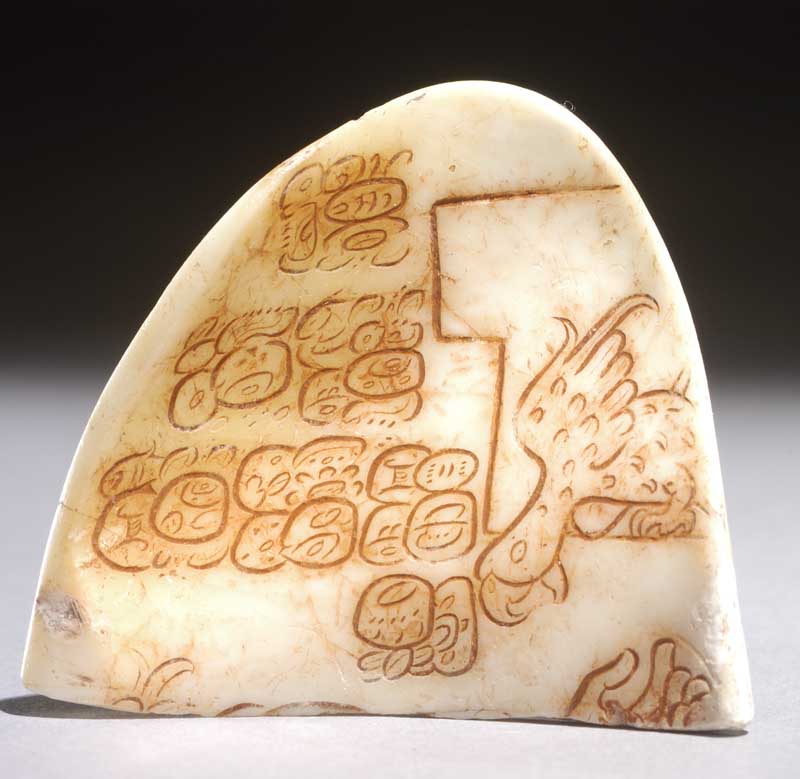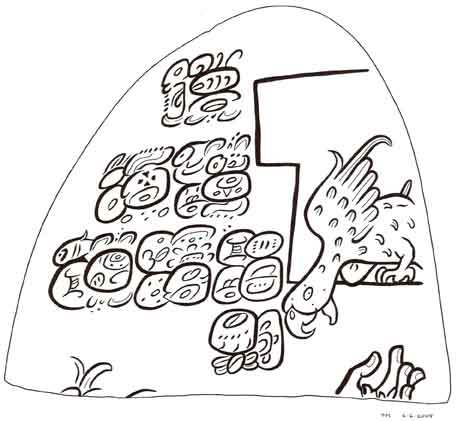
I have included portions of messages that pertain to this section of a shell? below. It was sawed and boken in antiquity and we do not
know what the actual object was, although the word for trumpet does occur in the text.. The image appears to be a parrot that
has flown into an IK shaped window, is standing on the sill and has leaned forward to take something from the upraised hand.

From Peter Mathews
Attempt at Free Translation:
You ...ed with my ... nest," said ...op, said the parrot.
This is the shell of Popol Tz'i, Head Scribe."
POPOL TZ'I A scribe(?) and parrot owner
Popol Tz'i is only known from one text, a fragment of shell that is exquisitely incised with his name and with a portrait of his pet parrot. The surviving shell contains only a part of the original scene: the parrot is perched on a window sill and is about to eat seed from a human hand—presumably that of Popol Tz'i himself. The hieroglyphic text begins with words said by the parrot; this is the first record we have of talking parrots kept by the ancient Maya. The name of the parrot is recorded at E1a. The first sign is presumably a word for 'parrot', written logographically with a parrot head. The second sign is the syllable sign b'i, presumably a phonetic complement indicating that the final part of the parrot name ends in –b' and probably in –ib'. (The specific identification of the parrot is uncertain. It seems quite animated, which means that it is not a Norwegian Blue.) The final part of the text simply says "It is the shell of Popol Tz'i, the B'a Cheb'". The last glyph is probably a scribal title (one of the captives portrayed on Piedras Negras Stela 12, a man apparently named Tub'naj, has the same title in his name).
What's in a Name?
The name glyph of Popol Tz'i is spelled out syllabically, in the following way po²-lo-tz'i-'i. (The second po sign is indicated by the pair of small dots immediately above the first po sign. These two dots were first identified by David Stuart [in Stuart and Houston 1994:46, 49, 50] as a means for 'doubling' the syllable to which they are attached—resulting in this case with po-po.) Popol Tz'i means 'Mat Dog' (that's 'Mat', with a 't', not a 'd').
Other Names and Titles:
The single surviving reference to Popol Tz'i contains a second glyph, which reads B'a Cheb'. The word cheb' is the word for a feather brush or quill pen, and occurs in texts accompanying scenes of painters and scribes. B'a means (among other things) 'first' or 'head', and occurs as prefix to several titles, such as B'a Ch'ok, 'First Youth', B'a Sajal, 'First Sajal'', B'a Uxul, 'First Sculptor', and so on. It is most likely, then that the glyph B'a Cheb' is a title meaning something like 'First Scribe' or 'Head Scribe'. Coe and Kerr 1997:98 cite Nikolai Grube, Linda Schele, and Mary Miller for the original identification of the B'a Cheb' glyph.
Portraits:
No portrait of Popol Tz'i has survived, but this shell probably originally contained one. His hand and the top of his headdress are visible just above the break in the shell.
List of Monuments Commissioned:
This shell is the only known record of Popol Tz'i. Given that he was probably a scribe, it is very likely that he incised the shell himself to commemorate his pet parrot.
From David Stuart
An important and gorgeous text, though murky in so many ways.
I can already see some very odd verbal forms, and perhaps some new lexical items.
One in the third block is me?-te for met, which is given as “crown” in proto-Ch’olan. Here’s a quick transcription:
a-wu?-le-li-ya
ti-ni-?-la
me?-te- a-a-la-ni
o(?)-po ya-[la]a-ji-ya
hu-b’i U-ju-chi
2po-lo tz’i(?)-i
b’a-ch’e-b’u
Generally I have a hard time with the whole thing,
but it seems that the owner of the shell (juch) may be named Popol Tz’i’,
and he carries that scribal B’aah Ch’ehb’ title.
Also, there’s a good possibility that there’s a 2nd person a- pronoun in the very first block,
and I like the presence of the possible wu syllable right afterwards, to give the transitional consonant,
possibly in something like: aw-(h)ul-el-iiy.
This could be a split-ergative form, but this is something we’ll all need to discuss and consider carefully.
From Steve Houston
There's some obvious stuff here that, of course, everyone will notice -- the personal pronouns [a-] and [ni],
as well as the glyph for "conch" and "shell-carving."
Dave pointed out the probably [me-te], perhaps for "crown" (The stuff before has to be adjectival, I'd think.)
In a linguistic note, I'm surprised and baffled by the odd spellings for "his saying," etc. I
t seems to be [ya-'a-la-ni] then [ya-'a-la-ji-ya]. Why the glottal stop, I wonder? Why the [ni]?
Oops, forgot to add the [ba-che-bu], probably /ba-a-chehb/, "head, first person of the quill."
Note from Justin. I realize that chebb literaly means quill, but in most contexts it doesn't make sense.
May I suggest that the meaning is something like "scribal tool", whether it be brush or engraving tool, as in this case.
From Mark Zender
Not only is the calligraphy remarkable for glyphs a little less than a centimeter tall,
but the text seems to be composed entirely of phonetic syllables.
I'm hard-pressed to think of another text this length (7 blocks, 35 signs) without so much as a single logograph.
Steve and Dave are right to single out the important first- and second-person forms.
Clearly, much of this text is intended to represent speech.
The TI-ni-ho?-la ("on my head?") is particularly intriguing,
and evokes the TI-ni-BAAH Dave pointed out some time ago on the "Birth vase".
But I'm most intrigued by the appearance of my [me] sign with [te]!
(Landa gave the first clue, of course, but there are other supportive spellings at Palenque and Copan.)
Dave suggests "crown" as a translation for /met/ (following Kaufman),
but most of the relevant dictionaries specify "yagual"
(the padded carrying ring used by Maya women to support water jugs on top of their heads).
Ch'ol and Chontal also have /met/ "nido" (nest).
This is where it would be really nice to see more of the iconography to the right of the text.
Like Dave, I'm sure I see a descending parrot's head, and perhaps part of his wing(?).
That [o-po] spelling is also pretty interesting.
Some of the languages have /op/ and /ohp/ as "anona" (sour sop);
but it's very unclear how this would relate to the rest of the text
(which remains frustratingly opaque overall).
That's no /ho/ in the second glyph block.
And even if it was, [ho-la] isn't the right spelling for "head", which should be [jo-lo]. .
From Barbara MacLeod
This has certainly been good for a couple of hours of bewilderment.
And entertainment.
I can suggest that perhaps the forms ya-'a-la-ni and ya-'a(la)-ji-ya form a couplet
wherein the root is 'a'al 'say'. This would be, however,
the Yucatecan form of the root (vs.*(h)al in proto-Ch'olan),
and nowhere outside Yucatecan, to my knowledge, has it been reconstructed as *'a'al.
Perhaps John can tell us more about this.
I am not suggesting that the text is Yucatecan; on the contrary,
a form like *y-a'al-an 'he says/said it' (in contrast with *y-a'al-(a)aj-iiy
'he has said it') approximates 'alan (t.v.) 'say many things'
in Tzotzil of Zinacantan (Laughlin 1975, p.43).
While non-CVC transitive verbs take a -(C)-Vn suffix in the Ch'olan languages,
'al is typically treated as if it were CVC. The Tzotzil 'alan suggests some historical irregularity, however.
If John regards the transitive -Vn as a future marker at the script horizon, we might kick that option around.
So... y-a'al-an -0 ?-po he says it.. ?? he will say it?? -?-po (subject)
y-a'al-aaj-iiy hu-bi he has said it-(deictic) -hu-bi (subject)
If this couplet were to refer to a scene on the part now lost,
it still seems odd that the name-tagging phrase ('his shell, first man of the quill') follows without a break.
As for what is being said (if this interpretation is at all valid)...
following suggestions by Steve and Dave we might have
'a-w-ul-el ti ni-?-la met 'it is your arrival at my ? nest' (considering the meaning '
nest' for /met/ in Ch'ol). This might perhaps complement a scene involving a parrot.
The sign above the po looks somewhat like the catfish being held by one of the
fishing Chahks on MT38D; it has the same little spines and parallel curving lines,
for what that's worth. All I can suggest is that that thing and the noun
(I assume) represented by hu-bi (a conch trumpet?) are the subjects of the couplet.
Is split ergativity being manifested in 'a-w-ul-el (if this proves correct)?
It might just be a nominalization (my preference)--
not more nor less than that puzzling 'u-lok'-ob? on
Copan St.
11,
meaning 'it is their departure (YKM and YP)'.
But these sorts of constructions were likely among the antecedents to split ergativity.

Drawing by Peter Mathews


